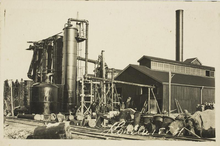New Consolidated Gold Fields Ltd Estonian Branch (commonly known as Goldfields) was an oil shale company located in Kohtla-Nõmme, Estonia. It was a subsidiary of Consolidated Gold Fields.
| Company type | Private limited company |
|---|---|
| Industry | Oil and gas |
| Founded | 1930 |
| Defunct | 1940 |
| Fate | Nationalized |
| Headquarters | , |
Key people | William Dunn (Chairman) |
| Products | Shale oil |
Production output | 11,400 tonnes of shale oil (1939) |
| Parent | Consolidated Gold Fields |
| Subsidiaries | Trustivapaa Bensiini |

New Consolidated Gold Fields began oil shale research and development in the late 1920s in England.[1] In 1930 it began construction of the shale oil extraction complex at Kohtla-Nõmme. It consisted of a shale oil extraction plant, a crushing mill, laboratory, power plant, office building and services facilities, as also housing for 30 workers, dispensary and sauna.[2] The first plant was built in 1931. The plant was equipped with eight rotating retorts (Davidson retorts).[3][4] Each of these retorts was capable of processing 15 tonnes of oil shale per day.[4] This facility continued to operate until 1961.[3] In 1934 the company doubled its production by building the second shale oil extraction plant.[5]
In 1934, Eesti Kiviõli and New Consolidated Gold Fields established the service station chain Trustivapaa Bensiini (now: Teboil) in Finland. During 1940 this chain sold more shale-oil-derived gasoline than did the entire conventional gasoline market in Estonia.[6] In 1937, the company opened the Kohtla underground mine.[3]
After the occupation of Estonia by the Soviet Union, the company was nationalized in 1940. The Kohtla-Nõmme shale oil extraction complex continued to operate until 1961.[3] The underground mine stayed operational until 2001.[7]
See also
editReferences
edit- ^ EPA (1979), p. C-10
- ^ "Inglise õlitööstus kerkib. Majandusministeeriumi juhid ehitustöödega tutvunemas" [British oil shale industry is progressing. Leaders of the Ministry of Economic Affairs Economy to familiarize with construction works]. Postimees. 1930-08-15.
- ^ a b c d Ots (2004), pp. 15–16
- ^ a b Lindquist, W. (1937-09-11). "Estländska oljeskifferindustrien" [Estonian oil shale industry]. Teknisk Tidskrift. Kemi (in Swedish) (9): 71–75. Retrieved 2014-03-31.
- ^ "Inglaste põlevkivikaevandus suureneb. Vabrik ehitatakse poolevõrra suuremaks" [British oil shale mining increases. The factory to be built a half bigger]. Postimees. 1934-05-24.
- ^ Holmberg (2008), pp. 112–114
- ^ Karu, Veiko; Valgma, Ingo; Kolats, Margit (2013). "Mine water as a potential source of energy from underground mined area in Estonian oil shale deposit" (PDF). Oil Shale. A Scientific-Technical Journal. 30 (2S). Estonian Academy Publishers: 336–362. doi:10.3176/oil.2013.2S.12. ISSN 0208-189X. Retrieved 2014-04-12.
Bibliography
edit
- EPA Oil Shale Research Group (1979). EPA program status report, oil shale. Interagency energy-environment research and development program report.
- Holmberg, Rurik (2008). Survival of the Unfit. Path Dependence and the Estonian Oil Shale Industry (PDF). Linköping Studies in Arts and Science. Vol. 427. Linköping University.
- Ots, Arvo (2006) [2004]. Toni Tyson; Mary McQuillen (eds.). Oil Shale Fuel Combustion. Tallinn: Arv Ots; Eesti Energia. ISBN 978-9949-13-710-7.